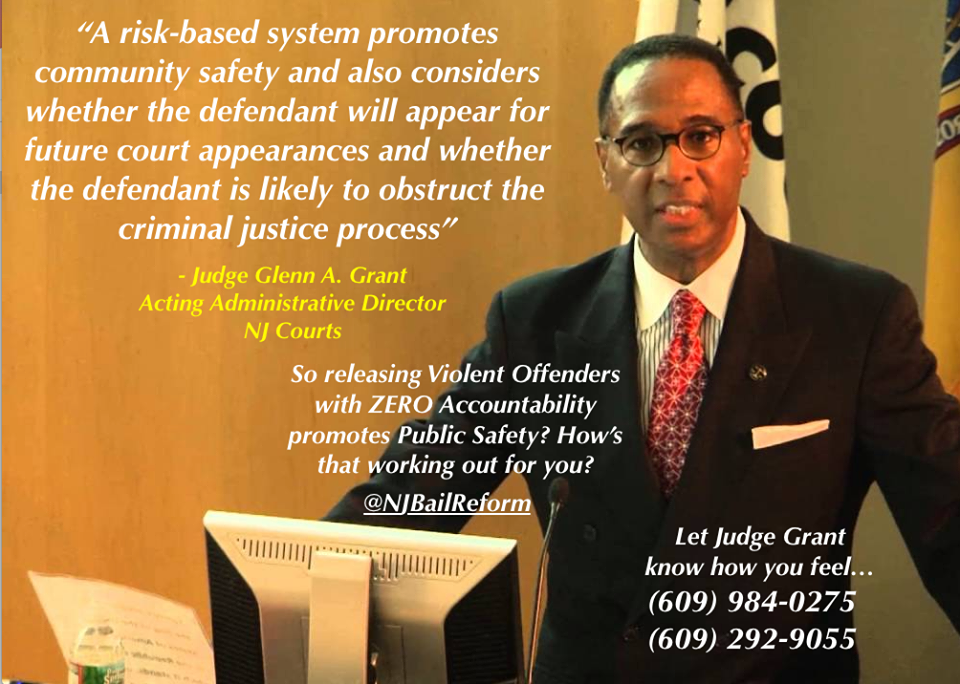
As New Jersey bail reform continues to frustrate law enforcement and elected officials, release dangerous offenders with ZERO accountability, and cost taxpayers millions – the NJ Judiciary and ACLU of NJ claim bail reform is a “success” by touting incomplete data and measuring its success solely on the number of unaccountable releases.
Judge Glenn A. Grant, acting Administrative Director of New Jersey Courts, testified before the Senate Budget and Appropriations committee on Thursday and claimed that bail reform was “off to a strong start” and that it “continues to meet its initial goals.”
If the measurement of success is the incredible number of unaccountable releases – well, he’s right. In a News Release issued shortly after his testimony, the judiciary supplied first quarter “statistics” that were incomplete and almost laughable. The stats, a mere break down of detention hearing results and the number of pretrial releases, is woefully inaccurate in determining the effectiveness of bail reform. The report is so comical, it almost makes you wonder…what are they hiding?

Over a month ago, US Bail Reform filed an OPRA request for information regarding bail reform. Our request was never filled despite several phone calls to top level judiciary employees.
Here are some of the statistics we requested – none of which are in the judiciary’s 1st Quarter Statistics;
- How many ankle monitors have been allotted to each county? How many specifically does each county have? Of those totals, how many are in use and how many are available?
- How many ankle monitor violations have their been since Jan 1, 2017? Of those defendants that have violated, how many have been remanded back to the jail?
- Of the total defendants being monitored under pretrial, how many pre-trial violations have been reported (total and by county)?
- Of the total defendants that were issued a CDR1, how many have reoffended or been charged with another offense?
- Of the total defendants that were issued a CDR1, how many have subsequently failed to appear at a court appearance? Of those, how many had a FTA warrant issued?
- Of the total defendants that were released OR, how many have reoffended or been charged with another offense?
- Of the total defendants that were released OR, how many have subsequently failed to appear at a court appearance? Of those, how many had a FTA warrant issued?
- Of the total defendants that were released by PTS on level 1 monitoring, how many have reoffended or been charged with another offense?
- Of the total defendants that were released by PTS on level 1 monitoring, how many have subsequently failed to appear at a court appearance? Of those, how many had a FTA warrant issued?
- Of the total defendants that were released by PTS on level 2 monitoring, how many have reoffended or been charged with another offense?
- Of the total defendants that were released by PTS on level 2 monitoring, how many have subsequently failed to appear at a court appearance? Of those, how many had a FTA warrant issued?
- Of the total defendants that were released by PTS on level 3 monitoring, how many have reoffended or been charged with another offense?
- Of the total defendants that were released by PTS on level 3 monitoring, how many have subsequently failed to appear at a court appearance? Of those, how many had a FTA warrant issued?
- Of the total defendants that were released by PTS on level 3+ monitoring, how many have reoffended or been charged with another offense?
- Of the total defendants that were released by PTS on level 3+ monitoring, how many have subsequently failed to appear at a court appearance? Of those, how many had a FTA warrant issued?
- Of those released by any form of pre-trial monitoring, how many active warrants have been issued for failing to appear or for pre-trial violations? How many of those are currently active fugitives?
- What are the procedures when there is a violation of pre-trial monitoring?
- Regarding the GPS ankle monitor, what is the manufacturer and model # of the monitoring device used?
So what about these statistics? Bail reform is a success because we released 8,931 offenders back on the street with zero accountability? Is that what you expect us to believe? For $500 Million, one would assume that the judiciary would have the capability to provide additional statistics to bolster their claim, right?
Furthermore, indictable warrants are down by roughly 50%. What that means is that more and more offenders are released on a summons than ever before…by a long shot. Why no stats on them?
So here is the abridged version of Judge Grants testimony…
- Filing fees are insufficient to pay for bail reform. We need more money.
- The 430+ judges we have need a raise. We need more money.
- We have no statistics to show you – other than to tell you how many we released with no accountability and how many we detained. That’s it and that’s all you need to know.
- Cops opinions only matter if they are in agreement with me – otherwise I am going to accuse them of wanting to jail offenders to punish them.
- I will only respond to the criticism of bail reform by using the word “tweak”…A LOT. Over and over and over.
- The offenders that “slipped” through the new system are the assistant prosecutors fault – not bail reform.
- Even though I claim that the Arnold Foundation’s secret formula (that nobody has the right to see) is a “validated and evidence based risk assessment” – I do concede that sometimes violent offenders and others that should be held will score a low score on the PSA, therefore, it’s up to the assistant prosecutor to catch that and file for detention.
- Even though I say that judges have more discretion under bail reform than the old system of bail, I like to throw prosecutors under the bus by reminding people that judges cannot file for detention – only prosecutors can. So, judges having more discretion only really applies to bail reform when I need to make it sound important.
- We need more money.
During his testimony, Grant seemed irritated by the onslaught of legislators questioning him about the repeated reckless release of offenders.
Several committee members brought to Grants attention the fact that law enforcement were extremely upset with bail reform – to which Grant responded with an insulting insinuation that law enforcement were upset because they were seeking to “punish” those arrested, as oppose to relying on the “evidence based tools.” Well, that should win you some points with the police unions, no?
It didn’t take long for the ACLU – the judiciary’s brother in arms – to chime in with a press release of their own…
Here’s what Alexander Shalom, senior staff attorney of the ACLU of New Jersey, had to say…

“The data from the first quarter of New Jersey’s criminal justice reform efforts reveal a process that is working extremely well. Naysayers, especially those with a stake in the old, unfair system, have tried to paint a picture of gloom and doom that simply doesn’t bear out. Statistics, not just anecdotes, demonstrate the success of reforms that have already made New Jersey a national model of a smarter, fairer and safer pretrial justice system.”
Once again, Shalom is painfully out of touch with reality. Clearly, the statistics provided are inadequate to measure any kind of success. If anything, it demonstrates what truly matters in the eyes of the judiciary and the ACLU – maximum release with the least restrictions – no matter the consequence to taxpayers, police, and victims. But hey, if it works for your agenda, then run with it right?
Judge Grant also mentioned recently that the ACLU would take part in talks with the Arnold Foundation in addressing the concerns of the algorithm. Funny, I can’t remember voting for anyone at the ACLU to represent the interests of taxpayers, can you?
New Jersey…you were taken for a ride in 2014 with a misleading ballot question that ultimately served the agenda of the ACLU, Drug Policy Alliance, judiciary, and lawmakers who bought in to the hip new bail reform sweeping the country.
Jail is not punishment – but it is a deterrent. Bail is not a punishment – but it is a deterrent that provides a layer of unmatched accountability.
First time offenders should be given an opportunity without the constraints of monetary bail – and the most dangerous of offenders should be held for the safety of our citizens.
What bail reform fails to address, however, is the other 80%…the very offenders US Bail Reform has been reporting on.
Judge Grant has often said recently “these individuals would have gotten out anyway under the old system.” Perhaps judge…perhaps not. If they would have, it certainly wouldn’t be on a “pinky promise” and, rest assured, it would be under real supervision by the surety and the family and friends that were required to sign for them – and certainly not on the backs of the taxpayer.
Bail reform is subsidizing criminal activity with taxpayer money making us less safe – no matter how you slice it – no matter how many subpar reports the judiciary publishes – no matter how much the ACLU throws their weight around pretending to be a champion for the indigent. We know it, the judiciary knows it, cops certainly know it, and the public is finally starting to see the light.
New Jersey Bail Reform, Risk Assessments, and Pretrial Services…
- ZERO Accountability
- ZERO Deterrent
- ZERO Supervision
- ZERO Bail…just a “pinky promise” to return
- Dangerous, Reckless, and a Taxpayer Burden

Thanks for letting dangerous criminals back on the streets. Asswipes.
You better gun up now America because it looks like the “wild wild west” is coming back. Why are our legislators doing this? Pockets are getting padded somewhere. And the innocent victims are going to suffer!